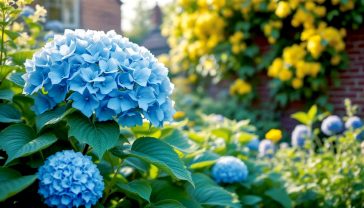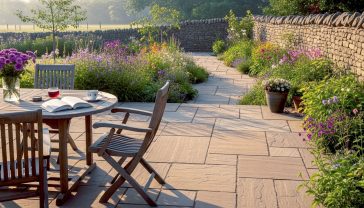Wattle Fence Panels: The Breakout Trend in UK Landscaping
Thinking about wattle fencing? This complete UK guide explains why woven hazel and willow panels are the breakout trend in sustainable garden design.

This post may contain affiliate links. If you make a purchase through these links, we may earn a commission at no additional cost to you.
Step aside, boring lap panels and predictable picket fences. There’s a rustic rebel making a comeback in British gardens, and it’s been around for thousands of years. We’re talking about wattle fencing. You’ve probably seen it without even realising—those charming, hand-woven panels that look like they’ve been plucked straight from a fairy tale.
But don’t let their old-world charm fool you. Wattle fencing is having a serious moment, and for good reason. It’s not just a fence; it’s a statement. It says you care about nature, you appreciate craftsmanship, and you’ve got an eye for style that goes beyond the garden centre catalogue. From trendy urban courtyards in Manchester to rambling cottage gardens in the Cotswolds, these woven wonders are popping up everywhere.
So, what’s all the fuss about? In this guide, we’ll unravel the story of wattle, from its ancient roots in Neolithic Britain to its modern-day revival as the go-to choice for eco-conscious gardeners. We’ll cover everything you need to know: what it is, how it’s made, why it’s so good for your garden, and how to get your own. Whether you’re a seasoned landscaper or a weekend gardening warrior, get ready to fall in love with Britain’s oldest and newest fencing trend.
What Exactly is Wattle Fencing?
At its heart, wattle fencing is beautifully simple. It’s a type of fence made by weaving thin, flexible branches or saplings around sturdy upright posts. Think of it like basket-weaving, but on a much larger scale. The name itself comes from the Old English word ‘watul’, which means to weave.
The panels are typically made from hazel or willow, two types of wood that are incredibly bendy and durable. The long, thin branches are called the ‘weavers’, and the thick upright posts they’re woven around are the ‘stakes’ or ‘zales’.
This technique, often called hurdling, has been used for centuries to create everything from sheep pens and garden dividers to the walls of ancient houses (in a method called ‘wattle and daub’, where a woven frame was covered in a sticky mix of mud, clay, and straw).
Today, you’ll mostly see wattle fencing sold as pre-made panels, known as hurdles. These hurdles are typically 6 feet wide and come in various heights, from a short 2-foot border to a tall 6-foot privacy screen. They arrive ready to be slotted between fence posts, making them a quick and surprisingly easy way to transform a garden.
The Two Stars of Wattle: Hazel vs. Willow
While other woods can be used, hazel and willow are the undisputed champions of the wattle world. They each have their own unique look and feel.
Hazel Hurdles: The Rugged Traditionalist
- Look and Feel: Hazel has a wonderfully rustic and slightly wild appearance. The branches are thicker and more varied in colour than willow, with a lovely mottled brown and grey bark. A hazel hurdle feels solid and substantial, bringing a real sense of the countryside to any space.
- How It’s Made: Hazel is often coppiced. This is a brilliant, ancient woodland management technique where trees are cut down to the stump. This encourages them to grow back with lots of long, straight stems, perfect for weaving. It’s incredibly sustainable because the tree is never killed. A single hazel stump can be harvested every 7-10 years for decades, or even centuries.
- Durability: Because the branches are thicker and left with their bark on, hazel hurdles are very strong and long-lasting. You can expect a well-made hazel fence to last for 8 to 10 years, sometimes even longer if it’s in a sheltered spot.
Willow Hurdles: The Sleek Modernist
- Look and Feel: Willow offers a more refined and uniform look. The branches are slimmer and smoother, often with a beautiful reddish or greenish hue. The weave is tighter and neater, giving it a more contemporary feel that works just as well in a modern city garden as it does in a country cottage.
- How It’s Made: Willow is harvested annually. The long, flexible stems, known as ‘withies’, are often steamed or boiled. This makes them extra pliable for weaving and also gives the wood a richer, darker colour. Some willow is stripped of its bark, creating a pale, creamy finish.
- Durability: Willow hurdles are slightly less robust than their hazel cousins. They typically have a lifespan of around 6 to 8 years. The thinner branches mean they can be more susceptible to damage from extreme weather or the odd stray football.
Choosing between them often comes down to personal taste. Do you want the chunky, rustic charm of hazel or the neat, elegant lines of willow? Both are fantastic, eco-friendly choices.
A Woven History: Wattle Through the Ages in Britain
Wattle fencing isn’t a new trend; it’s an ancient craft that’s deeply woven into the fabric of British history. Its story is the story of our landscape, our farms, and our homes.
From Neolithic Farmers to Roman Roads
The earliest evidence of wattle in Britain dates back an astonishing 6,000 years to the Neolithic period. Archaeologists have discovered fragments of wattle trackways, like the famous ‘Sweet Track’ in the Somerset Levels, built around 3807 BC. These woven walkways were laid across marshy ground, allowing our ancient ancestors to navigate the landscape.
These early communities also used wattle to build their homes and to create enclosures for their livestock. It was the original flat-pack furniture of the Stone Age—lightweight, easy to make from local materials, and surprisingly strong.
The Romans, ever the practical engineers, also saw the value of wattle. They used it to reinforce the banks of roads and to build temporary forts and defensive structures.
The Medieval Mainstay: Farming and Feudalism
Wattle truly came into its own during the medieval period. It was the backbone of rural life. Entire landscapes were managed through coppicing to provide a steady supply of wood for hurdles.
These hurdles were essential for farming. Shepherds used them to create movable pens, allowing them to manage their flocks in open fields. This system, known as folding, was vital for fertilising the soil. Each night, the sheep would be penned in a different section of a field, their manure enriching the ground for the next crop. You can still see the faint outlines of these sheepfolds in the bumps and ridges of ancient pastureland across the country.
Hurdle-makers were respected craftsmen in every village, their skills passed down through generations. It was a common sight to see them working in the woods during the winter, expertly weaving hazel or willow into panels that were essential for the entire community.
Decline and Revival
The arrival of the Industrial Revolution and new, cheaper materials in the 19th century saw the slow decline of wattle. Wire fencing became easier and faster to produce, and the old ways of the countryside began to fade. The ancient coppiced woodlands were neglected, and the craft of the hurdle-maker was nearly lost forever.
But in recent decades, something wonderful has happened. A renewed interest in sustainability, traditional crafts, and natural materials has sparked a wattle revival. Garden designers, conservationists, and homeowners have rediscovered its beauty and its environmental benefits.
Today, small businesses and skilled artisans across the UK are breathing new life into this ancient craft. They are managing the old woodlands, harvesting the wood sustainably, and weaving panels that connect our modern gardens to a story that stretches back thousands of years. When you install a wattle fence, you’re not just putting up a boundary; you’re becoming part of that story.
Why Choose Wattle? The Benefits for Your Garden and the Planet
So, why are so many people in the UK falling for wattle? It’s more than just a pretty face. Wattle fencing offers a unique combination of practical, aesthetic, and environmental benefits that standard fence panels just can’t match.
1. It’s Beautifully Natural and Blends In Seamlessly
This is the most obvious benefit. A wattle fence doesn’t shout for attention; it whispers. Its gentle, earthy tones and woven texture feel like a natural part of the garden. Unlike the harsh lines of a modern fence, wattle blurs the edges between your garden and the wider landscape.
It works with almost any garden style:
- Cottage Gardens: It’s the perfect backdrop for overflowing flowerbeds of roses, lavender, and foxgloves.
- Modern Gardens: Its organic texture provides a brilliant contrast to sleek paving, sharp architectural plants, and minimalist design.
- Wildlife Gardens: It creates a habitat and a natural look that encourages biodiversity.
Over time, it weathers to a beautiful silvery-grey, settling into its surroundings like it’s always been there.
2. It’s Fantastic for Wildlife
A standard fence panel is a dead barrier. A wattle fence is a living one. The nooks, crannies, and tiny gaps in the weave provide a vital habitat for all sorts of garden creatures.
- Insects: Ladybirds, lacewings, and solitary bees will happily shelter in a wattle fence, and these are the good guys who will help pollinate your plants and munch on pests like aphids.
- Birds: Wrens and robins love to hop along the top and hunt for insects within the weave.
- Amphibians: In damp, shady spots, a wattle hurdle can provide a cool, safe refuge for frogs and toads.
By choosing wattle, you’re actively creating a mini nature reserve in your back garden.
3. It’s a Sustainable and Eco-Friendly Choice
In an age of climate change and environmental concern, this is a huge selling point. Wattle is about as green as it gets.
- Renewable Resource: The wood, usually hazel or willow, comes from coppiced woodlands. As we’ve seen, this is a sustainable way of harvesting wood that actually benefits the woodland ecosystem by letting light reach the forest floor.
- Low Carbon Footprint: The process of making a wattle hurdle is very low-energy. There are no factories, no heavy machinery, just skilled hands and simple tools. And because it’s a traditional British craft, the wood is grown here in the UK, meaning it hasn’t been shipped halfway around the world.
- Biodegradable: At the end of its life, a wattle fence doesn’t need to go to a landfill. It can be broken up and composted, returning its nutrients to the soil it came from. It’s a perfect example of a ‘cradle-to-cradle’ product.
4. It’s Surprisingly Tough and Wind-Resistant
You might think a woven fence would be flimsy, but you’d be wrong. Wattle hurdles are incredibly resilient.
The key is in the weave. While a solid fence panel acts like a sail in high winds and can easily be blown over (as anyone who has woken up to a garden full of flattened fences after a storm knows), a wattle fence is different. The small gaps in the weave allow the wind to filter through it. This dramatically reduces the pressure on the fence, making it far more likely to withstand a British winter gale.
5. It’s Versatile and Easy to Install
Wattle isn’t just for boundary fences. Its versatility is one of its greatest strengths.
- Screening: Use taller hurdles to hide an ugly shed, compost bin, or your neighbour’s trampoline.
- Garden Dividers: Create ‘rooms’ within your garden, separating a vegetable patch from a seating area or a play zone from a quiet corner.
- Raised Bed Edging: Short hurdles are perfect for creating beautiful, rustic-looking raised beds for your veg or flowers.
- Plant Support: They make a fantastic natural-looking support for climbing plants like clematis, sweet peas, or runner beans.
Installation is also very straightforward. The pre-made hurdles are simply fixed to standard wooden fence posts. It’s a job that a competent DIYer can easily tackle in a weekend.
The Not-So-Perfect Side: Potential Downsides of Wattle
It’s only fair to look at the other side of the coin. While wattle is wonderful, it’s not the perfect solution for every situation. Here are a few things to consider before you buy.
1. Lifespan: It Doesn’t Last Forever
This is the biggest drawback compared to other fencing types. A pressure-treated timber panel might last 15-20 years, and a concrete or plastic fence will last even longer. As we’ve discussed, a hazel hurdle will last around 8-10 years, and a willow one 6-8 years.
You have to view it as a natural product with a natural lifespan. It will eventually biodegrade and need replacing. For many, this is a small price to pay for its beauty and environmental benefits, but it’s an important factor to budget for.
2. Privacy: It’s Not 100% Opaque
While wattle provides a good level of screening, it’s not completely solid. You can’t see through it clearly, but you might catch glimpses of movement or light from the other side. If you need total, absolute privacy, a solid fence panel might be a better option.
However, you can easily improve the privacy by encouraging climbing plants to grow up it. A covering of ivy, jasmine, or honeysuckle will quickly fill any gaps and create a beautiful living wall.
3. Cost: It Can Be More Expensive Upfront
Handmade, artisan products naturally cost more than mass-produced ones. A wattle hurdle will generally be more expensive than a basic lap panel from a big DIY store.
However, it’s important to think about value, not just price. You’re paying for a sustainably sourced, handcrafted product made in the UK. When you compare the cost to more decorative fence panels or high-end timber options, wattle often looks very competitive. Prices vary, but as a rough guide, you can expect to pay between £40 and £80 for a standard 6ft x 6ft hurdle.
4. Security: It’s Not a Fortress
Wattle is a great boundary marker and a visual deterrent, but it’s not a high-security fence. It’s relatively easy to climb over, and a determined intruder could break through it. If your primary concern is keeping burglars out, you’ll need to look at more robust, security-focused fencing solutions.
How to Install and Care for Your Wattle Fence
You’ve weighed the pros and cons and decided to go for it. Excellent choice! Here’s how to get your wattle hurdles installed and keep them looking great for as long as possible.
Installing Your Hurdles: A DIY Guide
Installing wattle hurdles is a very manageable project. The basic principle is to fix the hurdles securely to upright wooden posts.
You will need:
- Wattle hurdles
- Wooden fence posts (choose posts that are at least 2ft longer than the height of your hurdles)
- Postcrete or a similar fast-setting concrete mix
- A spade and a post-hole digger
- A spirit level
- A drill
- Screws or galvanised wire
- A tape measure and string line
Step-by-Step Instructions:
- Mark Your Line: Run a string line between two pegs to mark out the exact line where you want your fence to go. This ensures it’s perfectly straight.
- Dig the First Hole: At one end of your line, dig the first post hole. It needs to be about 2ft (60cm) deep. The width should be about three times the width of your post.
- Set the First Post: Place the post in the hole. Use the spirit level to make sure it’s perfectly upright on all sides. Pour in the Postcrete mix and add water according to the instructions. It sets very quickly, so double-check the post is straight before it hardens.
- Position the Hurdle: Place your first wattle hurdle against the post. Use it as a guide to mark where your next post hole needs to be dug. The hurdle should sit snugly between the two posts.
- Set the Second Post: Dig the second hole and set the post in the same way, using the spirit level to ensure it’s vertical and aligned with the first post.
- Attach the Hurdle: Once the concrete is set (this usually only takes about 20-30 minutes), you can attach the hurdle. The easiest way is to drill pilot holes through the sturdy side-weaves of the hurdle and into the post, then fix it with screws. Alternatively, you can lash it tightly to the posts using strong galvanised wire. Aim for at least three fixing points on each side (top, middle, and bottom).
- Repeat! Continue this process—dig, set post, attach hurdle—until your fence is complete. Regularly check your alignment with your string line and use the spirit level on every post.
Top Tip: Wattle hurdles are natural products and can vary slightly in width. It’s always best to measure each hurdle individually before digging the next post hole, rather than assuming they are all exactly 6ft wide.
Caring for Your Wattle Fence
One of the great things about wattle is that it’s very low-maintenance. It’s designed to be left to weather naturally. However, a little bit of care can help extend its life.
- Preservatives (Optional): Many people love the natural, silvery-grey look that wattle develops over time. However, if you want to maintain its original colour and add a bit of extra protection, you can treat it with a clear, water-based preservative. Some people use a 50/50 mix of linseed oil and turpentine. Apply it with a sprayer for the best coverage. Do this once a year in dry weather. Avoid using thick, varnish-like treatments, as these can crack and trap moisture, causing the wood to rot faster.
- Keep it Clear: Try to avoid letting soil and damp vegetation build up at the base of the fence. This is where rot is most likely to start. Use a stiff brush once a year to clear away any debris.
- Encourage Airflow: If possible, trim back any dense shrubs or overhanging branches that might be preventing air from circulating around the fence. Good airflow helps it dry out quickly after rain, which prolongs its life.
- Minor Repairs: If a single weaver branch breaks or comes loose, you can often push it back into the weave or secure it with a small nail or some garden wire.
The Future is Woven: Wattle in Modern Landscaping
Wattle fencing is more than just a passing garden fashion. It represents a wider shift in how we think about our outdoor spaces. It taps into key trends that are shaping the future of gardening and landscaping in the UK.
- Sustainability: As we all become more aware of our environmental impact, the demand for natural, locally sourced, and sustainable materials will only grow. Wattle ticks every box.
- Biophilic Design: This is the idea of connecting our homes and spaces with nature. Wattle fencing is a perfect example of biophilic design in action, using natural materials and textures to create calming, restorative environments.
- Rewilding and Wildlife Gardening: There is a huge movement towards creating gardens that are less manicured and more friendly to wildlife. Wattle fences are a key component of this, providing habitat and a natural aesthetic.
- Artisan and Craftsmanship: In a world of mass production, there is a growing appreciation for things that are made by hand, with skill and care. Each wattle hurdle is unique, carrying the mark of its maker.
Wattle fencing is a beautiful bridge between the past and the future. It’s an ancient craft that feels perfectly suited to the challenges and desires of the 21st century. It allows us to create gardens that are not only beautiful and functional but also kinder to the planet and richer in life. So next time you’re thinking about a new fence, look beyond the standard panels. Consider the woven wonder of wattle, and bring a piece of living history into your garden.
Further Reading
To explore this topic further, we recommend these highly respected resources:
- The National Coppice Federation: The UK’s leading organisation for promoting coppice products and woodland management. https://ncfed.org.uk/
- Woodland Trust: The UK’s largest woodland conservation charity, with excellent resources on sustainable woodland practices. https://www.woodlandtrust.org.uk/
- Royal Horticultural Society (RHS): A fantastic source of information on all aspects of gardening, including fencing and creating wildlife habitats. https://www.rhs.org.uk/






